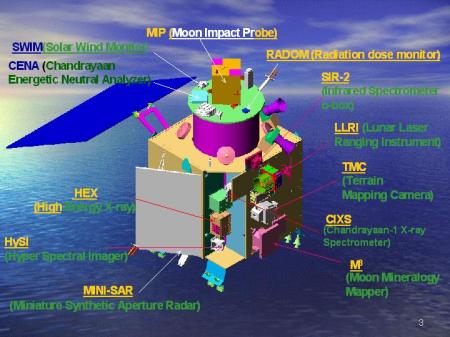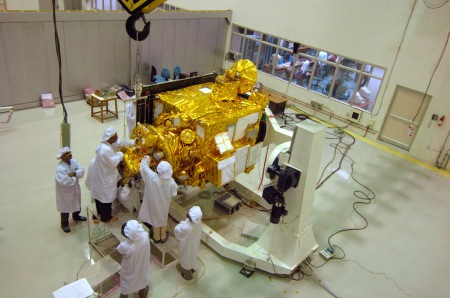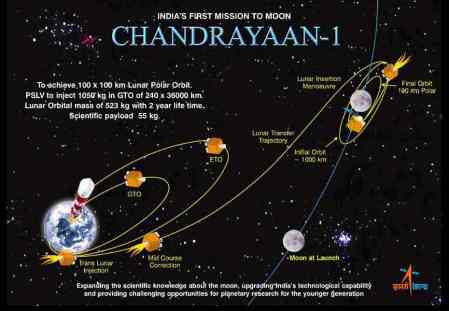Chandrayaan-1 gets ready for launch

All set: The fully assembled PSLV-C11, which will launch Chandrayaan-1 on October 22, stands encased in the Vehicle Assembly Building of the second launch pad at Sriharikota on Saturday.
October 21, 2008
With barely 24 hours to go for India’s maiden lunar mission, it is the most nerve raking period for people behind this Herculean task. The modified PSLV is all set to lift of from Sriharikota early tomorrow morning. If all goes according to plan, India will become the third Asian country to have put a satellite into a lunar orbit after Japan and China — which managed the feat just last year.
India has big future plans as well; cabinet has given the green signal for the Chandrayaan 2 mission in 2011, just three years from now. If that was not enough, current plan indicates a manned space mission in 2014 followed by a manned lunar mission in 2020 – which happens to be four years before China’s 2024 deadline. India also seems to be better placed than China as far as the moolah spent on these missions is concerned. The Chandrayaan -1 mission for example, with a budget of $86 million cost only half as much as China’s Chang’e 1 mission.
A space mission and that too a lunar mission is not just about sending a satellite across to the moon and the scientific intent it has. It is also a matter of national pride for most Indians who sit glued to their television screens during these launches. It is expected to be no different tomorrow.
However, experts point out that India’s mission is not just about chest-thumping or an egoistic attempt to increase its clout in the India dominated sub continent. India has as many as 11 communication satellites of its own, which the country has used to its benefit. The INSAT series of satellites have been instrumental in bringing quality education to remote villages in the heart of rural India. This is apart from the IRS, which has helped farmers indirectly for crop yield modeling.
Four decades ago, when the US and Russia were embroiled in a bitter space-race for reaching the moon , sleeping giants India and China were barely a blip on the radar. No one could have envisaged that these countries will in just 40 years start to dramatically shift the highly polarized world economy eastwards.
While the US still is the indisputable superpower, India and especially China has been seeing dramatic growth over the past few decades. While India has not ruffled half as many feathers as China has, it has had its share of limelight — with the Chandrayaan mission being one of the highly decorated feathers on the proverbial cap.
Coming back to the Chandrayaan -1 mission, while most have lauded the efforts by the scientists and engineers behind this mission, there are some others who have voiced their resentment against a mission of this nature; mainly questioning the rationale behind spending colossal amounts of money when the country can spend this amount on “better” things. These include ensuring basic necessities for the country’s poverty stricken masses and other humanitarian needs. While many see a possible “space race” with China in harnessing the lunar mineral wealth, others point towards an arms race claiming that rockets used for firing satellites can also be used for nuclear warheads.

Courtesy: ISRO, India
It looks as if the dream come true, the Chandrayaan-1 mission is India’s first lunar spacecraft, which was announced by Ex Prime Minister Mr. Atal Bihari Vajpayee on Indian Independence Day, August 15, 2003. He said “Our country is now ready to fly high in the field of science. I am pleased to announce that India will send her own spacecraft to the moon by 2008. It is being named Chandrayaan-1“. Chandrayaan (an ancient Sanskrit word) means “Moon Craft”. The maiden journey of the moon probe is expected to be on 22 October 2008. According to astrologers also, this auspicious date is good for the mission.

The Main Objectives are :
- To expand scientific knowledge about the moon.
- To upgrade India’s technological capability.
- To provide challenging opportunities for planetary.
Chandrayaan-1 aims to achieve these well defined objectives through high resolution remote sensing of the moon in the visible, near infrared, microwave and X-ray regions of the electromagnetic spectrum. With this, preparation of a 3-dimensional atlas of the lunar surface and chemical mapping of entire lunar surface is envisaged.

Chandrayaan-1 consists of 5 Indian payloads :
- Terrain Mapping Camera (TMC)
- Hyperspectral Imager (HySI)
- Lunar Laser Ranging Instrument (LLRI)
- High Energy X-ray Spectrometer (HEX)
- Moon Impact Probe (MIP)
It also consists of six abroad payloads :
- Chandrayaan-1 Imaging X-ray Spectrometer (C1XS) – by Rutherford Appleton Laboratory of England and ISRO Satellite Centre, Bangalore.
- Smart Near Infrared Spectrometer (SIR-2) – by Max Plank Institute of Germany.
- Sub keV Atom Reflecting Analyser (SARA) – by Swedish Institute of Space Physics and Space Physics Laboratory (SPL) of ISRO’s Vikram Sarabhai Space Centre built its processing electronics.
- Radiation Dose Monitor (RADOM) – by Bulgarian Academy of Sciences.
- Mini Syntheic Aperture Radar (MiniSAR) – by Johns Hopkins University’s Applied Physics Laboratory and Naval Air Warfare Centre, USA through NASA.
- Moon Mineralogy Mapper (M3) – by Brown University and Jet Propulsion Laboratory through NASA.

The Trajectory of Chandrayaan …
The launch of Chandrayaan
- R




0 comments:
Post a Comment